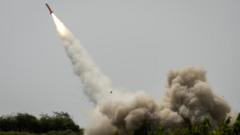As the U.S. and China escalate their trade conflict, the focus has shifted to global supply chains. Recent actions taken by both nations to restrict critical technologies have significant implications for multiple industries, including aviation as both countries grapple with their interdependence.
U.S.-China Supply Chain Showdown: A New Chapter in Trade Tensions

U.S.-China Supply Chain Showdown: A New Chapter in Trade Tensions
The ongoing U.S.-China trade conflict shifts from tariffs to control of global supply chains, raising alarms across industries reliant on shared technologies.
The U.S.-China economic relationship is entering a precarious phase as trade disputes evolve from traditional tariffs to a more complex battle over global supply chains. Both nations are now implementing measures to restrict the flow of critical technologies, leading to wider consequences across various sectors.
The United States has recently halted sales of crucial components and software for jet engines and semiconductors to China, responding to Beijing's restrictions on the export of rare earth minerals essential for manufacturing. This escalation has resulted in accusations of bad faith from both sides and has raised concerns among businesses that rely on an interconnected supply chain.
The aviation sector has become a focal point in this ongoing conflict, emerging as both an instrument of leverage and a major casualty. Technologies for jet engines and navigation systems predominantly originate from American firms like General Electric. However, the manufacturing of these advanced engines requires rare earth minerals processed in China, underscoring the complex interdependencies involved.
In April, in retaliation to President Trump’s imposition of high tariffs on Chinese imports, China restricted the export of these critical minerals, igniting fears within the U.S. that dependence on Chinese supply chains could impact various industries, including pharmaceuticals and logistics. The current landscape of U.S.-China trade represents a stark transformation where both nations must navigate their economic aspirations amid the threat of supply chain disruptions.




















